How 2020 Can Be the Year of the Homeowner in New York
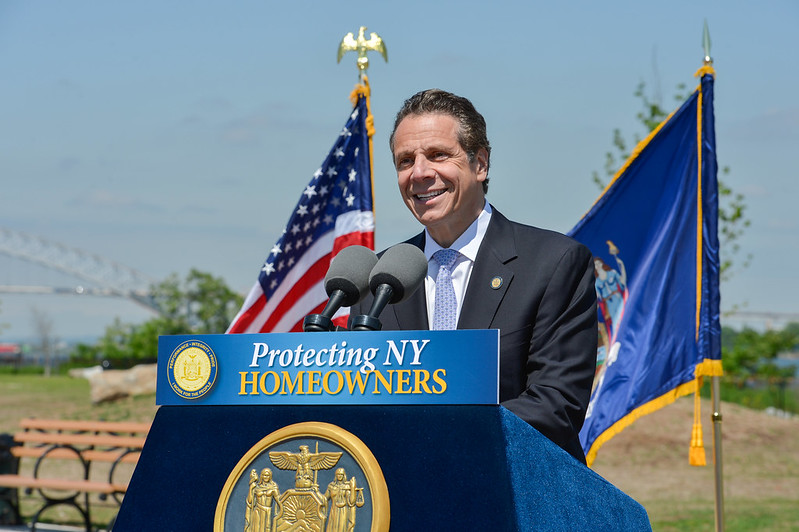
(photo: the governor's office)
This year New York state government passed historic housing affordability reforms achieved by the pro-tenant Housing Stability and Tenant Protections Act of 2019, but a truly equitable approach to the state’s affordable housing landscape requires opportunities for working families to build equity. Now it is time for Albany to address the long-neglected affordable ownership sector of the housing continuum by passing a similar package of comprehensive legislation aimed at supporting existing affordable homes, as well as the creation of new low-to-moderate-income, first-time homebuyer opportunities.
Affordable rental housing often receives the lion’s share of attention within the framework of New York’s housing crisis, despite the fact that New York City has one of the lowest rates of homeownership in the country and that affordable homeownership creates unique benefits of community and family stability.
However, each segment of affordable housing – affordable ownership, rentals, public housing, etc. – is intertwined in a continuum. For example, a family given the opportunity of affordable homeownership is more likely to leave behind a rent-stabilized or otherwise affordable rental unit, freeing up that unit for another family.
We have seen this firsthand at Habitat for Humanity New York City, as a significant number of our first-time homebuyers have transitioned into homeownership directly from public housing units operated by NYCHA. This cascading effect frees up units along the housing continuum, so that by helping one family, we are actually providing opportunities for more rent-burdened families and by extension, providing a path forward for even those impacted by homelessness.
Conversely, when would-be-homebuyers are unable to find their affordable starter home to purchase, they stay in their rental unit, stagnating the opening up of affordable units to those who may be in more critical housing need. For example, the foreclosure crisis had a cascading effect beginning with fewer new homeowners, increasing rents and spikes in homelessness rates.
New York City’s already low homeownership rate also skews toward white families supporting a systemic racial imbalance in affordable housing availability that has gone from bad to worse, since the financial crisis of 2008. Decades of racist redlining have prevented countless families of color from ever entering the housing market throughout the 20th century and depressed generational wealth and homeownership rates for non-white families. Nationally, the number of black families who own their own homes has dropped to 1960 levels, or 40.6 percent, compared to a white homeownership rate of 73.1 percent – effectively setting the clock back to levels that pre-date the Fair Housing Act.
The reasons for a low homeownership rate in New York City are complicated, but what stands out are the significant barriers to becoming a first-time homebuyer. For most New Yorkers, homeownership is just too far out of reach: A report from StreetEasy earlier this year found that New Yorkers would need to accumulate savings over an average of 18 years – more than 10 times the national average – before they could even afford a median-priced home within the five boroughs. A 2016 study by NYU’s Furman Center further found that home prices rose by more than 200 percent over the last 25 years, meanwhile median household income, adjusted for inflation, fell by 11 percent.
State and local policies have also had a significant impact in shaping the city’s housing continuum. For decades, funding levels for rental housing programs have vastly outpaced homeownership programs, leaving limited resources for home-builders across the state. Municipal processes like the tax-lien sale have disproportionately impacted communities of color and homeownership opportunities keep getting converted to rental housing when sales do occur.
There are several policies state government in Albany could implement in the next session to turn the tide and provide more opportunities for working-class New Yorkers to become or remain homeowners.
1. Increase construction and rehabilitation funding for permanently affordable homeownership.
The Affordable Housing Corporation, the state’s primary source for new homeownership construction funding, has not received a significant increase over the last 30 years. Assembly Member Latrice Walker and Senator Jamaal Bailey have each introduced legislation that increases the per-unit allocation for home-ownership units while also requiring that projects accessing increased funds require permanent affordability restrictions, ensuring long-term public benefit for increased investment.
2. Create a Cooperative Ownership Opportunity Program (COOP).
With many affordable housing buildings entering their regulatory sunset years and at risk of going market-rate, the creation of a Cooperative Ownership Opportunity Program (COOP) could enable non-profit technical and legal service support for tenants interested in purchasing their expiring LIHTC buildings, Mitchell-Lama Article II buildings, mobile-home parks, and other rent-regulated buildings. And unlike previous cooperative conversion programs, these new cooperatives could be established with proper pre-purchase education, community land trusts, and monitoring stewardship, and updated regulatory agreements to ensure long-term success.
3. Establish a Community Land Trust (CLT) tax exemption for permanently affordable housing on CLT land.
CLTs limit the resale price of the homes, helping to maintain affordability for the next generation of land trust residents and protect against the loss of scarce affordable housing when the home is resold. The state should pass legislation that qualifies CLT-owned land as tax exempt under the not-for-profit 420-a tax law and either establish a new exemption for CLT homes and buildings or direct taxing authorities to appropriately assess the homes at a reduced rate in accordance with the resale restrictions.
4. Allocate $25M to the New York State Community Development Financial Institution Fund (CDFI Fund).
The NYS CDFI Fund was established in 2007 to provide competitively-awarded grants and investments to New York’s CDFIs, which in turn provide equitable financial services in neighborhoods not traditionally served by mainstream banks, helping low-income New Yorkers build wealth and establish credit. Some CDFIs also provide low-interest mortgages, cooperative share loans, preservation rehab financing, and energy efficiency lending to low-income cooperatives to help sustain long-term affordability. However, since its historic inception as the first state-based fund of its kind, New York has yet to allocate any funding to the NYS CDFI Fund.
5. Creation of an Affordable Cooperative/Condominium Ombudsman.
Affordable cooperative and condominium housing is an important portion of New York state's affordable residential housing stock. Inevitably, however, disputes that arise between developer sponsors, shareholders and owners, boards of directors and management companies often result in lengthy and costly litigation and divert resources that could be better utilized to maintain and sustain the buildings. By establishing an Affordable Cooperative/Condominium Ombudsman, all parties involved in residential cooperative and condominium ownership and governance would have access to a neutral and informative resource – something desperately needed to ensure the long-term success of this valuable housing stock.
6. Reform the Private Housing Finance Law (PHFL) and Martin Act in relation to HDFCs to strengthen the stewardship and preservation of affordable cooperative homeownership.
The Legislature should amend the PHFL to clarify the permanent affordability of HDFC cooperatives and empower the Attorney General and housing agencies with increased oversight and enforcement powers to root out abuses. This may also include the creation of an amnesty for non-compliant HDFC cooperatives to exit their regulatory status in exchange for financial restitution dedicated to the creation and preservation of affordable homeownership, as well as increased tax forgiveness for distressed HDFC cooperatives that agree to enhanced oversight.
The Legislature should also fix the Martin Act to encourage rental-to-cooperative and -condominium conversions, while protecting all tenants during the process, as well as ensuring that rental conversions result in viable cooperatives and condominiums through the sale of units to bona fide purchasers.
These modest but needed investments in affordable homeownership at the state level will provide countless families the support they need to move from permanent renters to homeowners. It will give more families of color the opportunity to become homeowners and will strengthen historically nonwhite neighborhoods against the negative effects of gentrification.
Critically, a family that is given the opportunity to purchase an affordable home now shares in the benefits uniquely associated with ownership. Homeownership is a tool that helps families build strength, stability, and self-determination and is a foundation for economic mobility. It is time for Albany to work on pro-equitable homeowner legislation and make 2020 the Year of the Homeowner.
***
Matthew Dunbar is Vice President of External Affairs at Habitat for Humanity New York City. On Twitter @misterdunbar & @HabitatNYC
***
Have an op-ed idea or submission for Gotham Gazette? Email This email address is being protected from spambots. You need JavaScript enabled to view it.
A Historic Day for Animals in New York City
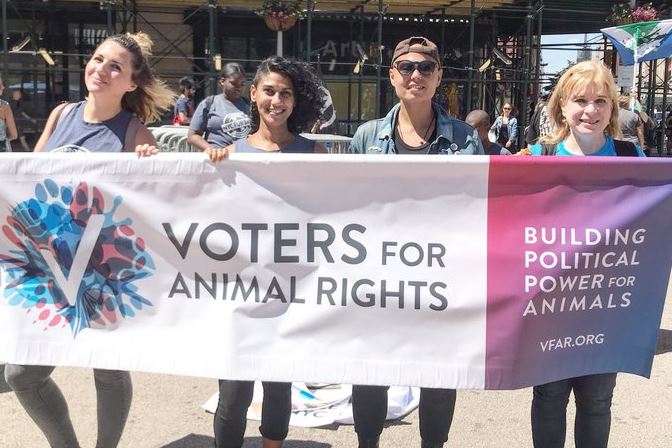
(photo: @theanimalvoters)
A landmark package of nearly a dozen animal protection measures is set to pass the New York City Council this week, championed by Speaker Corey Johnson, along with several other members. The strength of our city’s progressive roots grows deeper with the passage of this animal protection package, and it will be a defining moment in our city’s history.
What does it say about a society that allows horses to pull carriages in rush-hour traffic in the blistering summer heat or restaurant menus to offer for sale a product that comes from the diseased liver of a tortured duck force-fed with a foot-long pipe?
On the other hand, what does it say about a City Council speaker and Council members who stand against these blatant cruelties to animals? We believe it says everything about them because, in the end, our true moral test consists of our actions or inaction toward those who are at our mercy.
Among the nearly dozen measures set to pass, four stand out most notably.
A bill sponsored by Council Member Justin Brannan, Intro 1478A, will make New York the first city in the nation to establish an Office of Animal Welfare within the Mayor’s office. A bill sponsored by Council Member Keith Powers, Intro 1425A, will prohibit the abusive horse-carriage industry from working horses on extremely hot and/or humid days.
A bill sponsored by Council Member Carlina Rivera, Intro 1202A, seeks to deter and punish individuals who steal wild birds from our city’s parks. And another bill sponsored by Council Member Rivera, Intro 1378A, would prohibit the sale of force-fed foie gras in New York—the largest foie gras market in the country. The foie gras sales ban bill has more support than any other bill in the package, including a coalition of over 50 not-for-profit organizations led by Voters For Animal Rights, 50 New York-based veterinarians, 30 Council co-sponsors, over 90 New York City-based restaurants, and 81% of New York City voters, according to a Mason Dixon poll.
Foie Gras—French for fatty liver—is a gruesome luxury food product made from the diseased and enlarged liver of a duck produced through force-feeding. Ducks abused by the foie gras industry suffer immensely from ruptured organs, esophagus trauma, broken bones, illnesses, and diseases as a result of having a foot-long metal or plastic pipe shoved down their throats and a large mass of food injected into their delicate digestive system several times a day for weeks. The sole purpose of this barbaric force-feeding is to swell and disease the bird’s liver to ten times its normal size so it can be sold as foie gras.
The force-fed foie gras sales ban legislation exemplifies the historic nature of this animal package moving through the City Council. First, it is one of the most important animal protection bills passed by any city in the country on account of the vast number of animals it will save per year. Second, rarely in politics do you see unpaid grassroots volunteer-run organizations — like those at Voters for Animal Rights — take on and win against multimillion-dollar companies with high-paid lobbyists. Lastly, the sheer brutality behind the production of foie gras provides important context to the plight of farmed animals on industrial farms, such as the ducks on Hudson Valley Foie Gras and La Belle Farms.
These measures send a strong and clear statement to the world that New Yorkers reject the notion that animals are mere property, but rather sentient beings whose capacity for suffering affords them the right to legal protection from cruelty.
This package represents far more than just a few laws that protect horses, ducks, and pigeons from abuse. It is irrefutable evidence of our moral progress as New Yorkers.
Gandhi famously asserted that “the greatness of a nation and its moral progress can be judged by the way its animals are treated.” While we certainly have a long way to go when it comes to protecting animals from abuse, this is a landmark of progress and surely a moment worth celebrating. Speaker Johnson, Council members, your leadership on this issue is commendable and well-deserving of praise.
***
by Allie Feldman Taylor & Matthew Dominguez, Voters for Animal Rights. On Twitter @AllieFeldman212 & @Matt_Dominguez & @theanimalvoters. And co-signed by coalition partners:
Humane Society Veterinarian Medical Association
Animal Legal Defense Fund
World Animal Protection
Physicians Committee for Responsible Medicine
Compassion in World Farming
Farm Sanctuary
Barn Sanctuary
Woodstock Sanctuary
Four Paws
Animal Protection Rescue League
Animal Defenders International
In Defense of Animals
Last Chance for Animals
Compassion Over Killing
Lady FreethinkerTheir Turn
***
Have an op-ed idea or submission for Gotham Gazette? Email This email address is being protected from spambots. You need JavaScript enabled to view it.
Getting in the Holiday Spirit of Improved Public Space
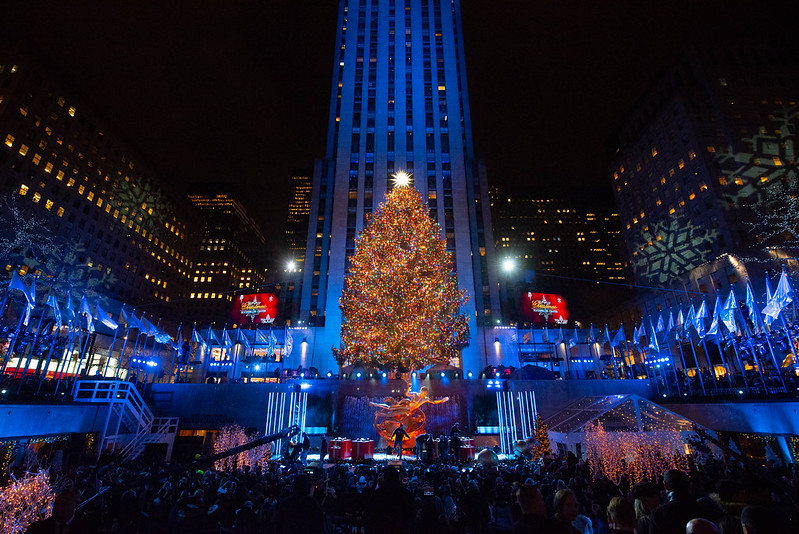
(photo: Michael Appleton/Mayor's Office)
‘Tis the season for improving public spaces.
The 14th Street busway has been live for just over three weeks and the accolades are already enough to deem its opening as historic. New Yorkers are now seeking more innovative ideas to improve the pedestrian and commuter experience throughout the city.
With the holiday season approaching, we are hopeful that this embrace of open space can be adopted in Midtown.
Rockefeller Center is one of the centerpieces of Manhattan. Every year, the area sees close to 1 million pedestrians during the holidays. It’s the must-see destination for both New Yorkers and tourists, and one of the places where the city absolutely shines.
But if you are looking anywhere other than the top of the tree, it’s a sea of people and cars competing to get a glimpse of the scene.
If we think of Rockefeller Center with a people-first mentality, we can make streets safer and enrich public space. That’s why we have called for the City to pedestrianize the historic plaza by closing 49th and 50th Streets from 5th Avenue to 6th Avenue for the holiday season.
The current set up relies on blockades that take up large amounts of space and cause groups of pedestrians to crowd crosswalks and spill over into the street: a recipe for injuries. And each day, the parameters change. With a defined set-up, rules of the area would be more easily communicated and expectations clear.
Ten years ago, Times Square took the jump to clear out cars. Five streets transformed into 110,000 square feet of pedestrian space. The successes of the Department of Transportation's endeavor are indisputable. Pedestrian injuries have decreased by 40% and vehicular crashes have decreased by 15% after the streets became a plaza. The number of individuals passing through increased, too: a boon to area businesses.
Rockefeller Center is a 12-acre landmark in the middle of Manhattan, open to New Yorkers and visitors -- it is time we protect the space and everyone who visits, and encourage even more people to take part safely.
There is nothing like New York during the holidays. Let’s prepare for the celebration and those to come. The countdown is on.
***
Gale A. Brewer is the Borough President of Manhattan. Keith Powers is a City Council Member for Manhattan’s East Side, including the Rockefeller Center area. On Twitter @galeabrewer & @KeithPowersNYC.
***
Have an op-ed idea or submission for Gotham Gazette? Email This email address is being protected from spambots. You need JavaScript enabled to view it.
Keeping the Lights On, and Saving Billions, While Addressing Climate Change

Indian Point (photo: the governor's office)
New York’s recently-passed Climate Leadership and Community Protection Act has been described as the boldest climate legislation in the nation. It sets demanding milestones for reducing carbon emissions, starting with the 2030 goal that New York state should, by then, derive 70% of its electricity from renewable sources (solar, wind, and waterpower). By 2040, it should derive all of its electricity from “clean” sources, and it should be carbon-neutral in all its uses of energy by 2050.
These goals pose daunting challenges, but within two years the challenge will become even greater when the Indian Point nuclear plant, 36 miles up the Hudson River from New York City, is scheduled to shut down. Governor Cuomo agreed to its closure, even though it is functioning safely and economically, because of fears of a nuclear accident raised by the community around the site. When he agreed to the closure, he made a commitment it would not result in any new carbon emissions. Nevertheless, the operator of New York’s electric grid has made clear that three natural gas-powered generating plants will be fired up to replace the carbon-free electricity flowing from Indian Point. These replacement plants will release 7 million metric tons of greenhouse gases for each year thereafter. The increased greenhouse gas emissions will undermine the new climate law before it even gets started, and the smaller capacity of the gas plants may well lead to shortages of electric power in the coming years.
We have shown elsewhere that attempting to meet the new law’s 2030 goal with only renewable sources would cost more than $100 billion and is completely impractical. However, the language of the new climate law ignores the contribution that nuclear power, which emits no carbon dioxide, can make toward a carbon-free future. Indeed, if Indian Point and other nuclear plants, which already provide nearly a third of New York’s electricity, are kept running, and the governor’s planned expansion of offshore wind takes place, a 2030 goal of 70% carbon-free electricity will be met without any further expenditure.
There is no need to shut down Indian Point. This facility, which produces a quarter of the New York City Metro region’s electricity, is safe and reliable and can keep going for decades more. The current closure agreement does allow the plant, if necessary, to continue operating through 2024 and 2025. While the current operator, the Entergy Corp., is giving up control of the plant, the New York Power Authority could take it over and continue operating it, as it did safely and efficiently for many years before Entergy came into the picture. In fact, Indian Point should remain operational until such time as new, carbon-free resources can replace it. That way, it can continue to help meet the state’s emission reduction goals.
We recognize that including nuclear energy, along with carbon-free renewable energy sources, in meeting our climate goals will require a major re-evaluation of risk by groups deeply invested in opposing nuclear power. These groups, some of which campaigned for the closure of Indian Point, are concerned that nuclear reactors will suffer accidents that could have catastrophic consequences. In fact, as one of us has explained in a brief guide, this is not possible. Nuclear reactor accidents have led to very few deaths – 28 plant workers and firefighters perished at Chernobyl, along with an estimated 60 deaths from thyroid cancer worldwide -- and there were zero fatalities from the Three Mile Island and Fukushima events. Hundreds of thousands have already suffered from the effects of climate change, and millions more are likely to suffer if climate change proceeds as it is on course now.
Keeping Indian Point and other nuclear plants operating while the state builds new, even safer nuclear facilities and installs modest amounts of renewable resources offers the most practical, achievable path for New York to meet its emission goals and offer our children and grandchildren a realistic chance for a carbon-free, stable future.
***
Leonard Rodberg is a physicist who taught climate change and public policy at Queens College/CUNY until his retirement in 2017. Herschel Specter is an engineer who focused on nuclear safety issues in many positions, including at the Nuclear Regulatory Commission and the International Atomic Energy Agency.
***
Have an op-ed idea or submission for Gotham Gazette? Email This email address is being protected from spambots. You need JavaScript enabled to view it.
Letter to the Editor: Toy Companies in New York and Across America Put Child Safety First

(photo: @TheToyAssociation)
To the Editor,
As the not-for-profit association representing businesses that create and deliver toys to kids, The Toy Association counts 126 companies in New York State among its membership of more than 1,100 toymakers and retailers. Every single one of these companies prioritizes keeping children safe at play, above all else.
I’d like to set the record straight regarding the mistruths and inaccuracies in Christine Appah’s opinion piece, “The Governor’s Signature is Next Step in Protecting New York Children from Toxic Toys” (Oct. 11).
Appah states that “there are many toys and products on the market today that do indeed contain chemicals that are hazardous to children’s health,” and that the Child Safe Products Act, if signed into law by Governor Andrew Cuomo, could “prevent further unnecessary harm to children on his watch.”
In fact, U.S. toy safety requirements are among the strictest in the world. By law, all toys sold in the United States must comply with more than 100 rigorous safety tests and standards, including the Federal Hazardous Substances Act, the Consumer Product Safety Act, and the Consumer Product Safety Improvement Act. Among other protections, these regulations make it illegal to sell toys or children’s products containing substances harmful to children and to which they might be exposed.
There is a narrative circulating regarding the Child Safe Products Act that’s not based on any scientific studies related to children’s products and oversimplifies a complex issue by saying it will protect kids. In actuality, this bill in no way assesses the safety of the products concerned, and therefore any claims that this would make products safer is simply inaccurate. Disclosure of substances under this legislation is triggered based on their presence and not on any health or safety-based values, and completely ignores whether exposure to the substances is likely or even possible.
What we do know is that the bill will limit consumer choices, as beloved, safe toys that are available elsewhere in the country and internationally will be taken off local store shelves; drive up costs; and threaten 21,000 jobs in New York State.
This legislation fails to consider the numerous federal safety and environmental regulations that all toys sold in the U.S. must comply with. These statutes and ensuing regulations administered by the CPSC already ensure that any children's products that present any hazardous exposure to a child cannot be legally sold in the United States.
Toys are consistently ranked among the safest consumer product categories found in the home. This legislation is trying to solve a problem that doesn’t actually exist.
Rest assured that America’s and New York’s toymakers are committed to keeping children safe.
Sincerely,
Matthew Lenz, Director of State Government Affairs, The Toy Association
@TheToyAssoc
***
Have an op-ed idea or submission for Gotham Gazette? Email This email address is being protected from spambots. You need JavaScript enabled to view it.
The Candidate That Wins Should Get At Least Half The Votes
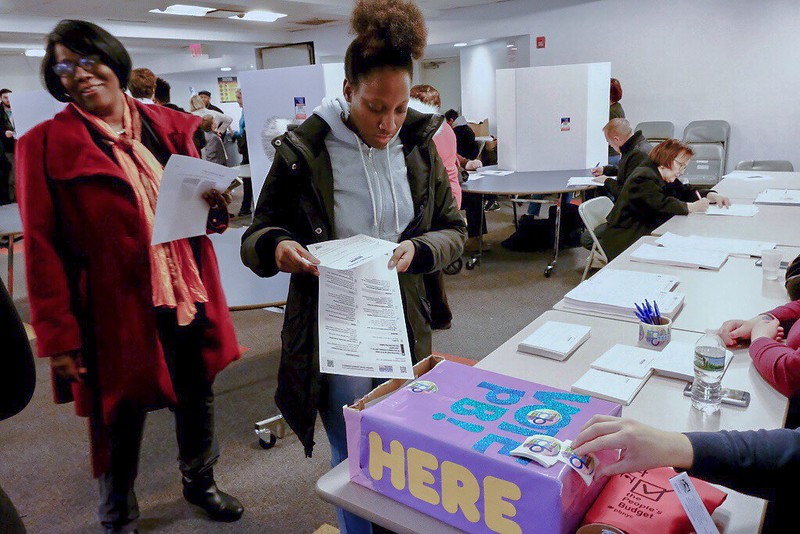
(photo: City Council)
Suppose eight candidates are running for Mayor or a City Council seat or another New York City office. On election night, the results are extremely close: The top candidate gets 29% of the vote, and the second 28%. Even though 70% of voters picked someone else, a candidate with less than one-third of the votes will become the elected representative of 100% of the office’s jurisdiction.
This situation may seem unlikely, but it’s precisely what happened in a 2013 special election for New York City Council, when Donovan Richards defeated special election opponent Pesach Osina by only 79 votes. The district is mostly African-American, and except for Osina, the candidates were African-American. However, because the vote was split among six African-American candidates, Osina almost became the district’s nominee with only 28% of the vote. This election was not that unusual: In 2013, 14 of the 21 New York City Council primaries for open seats were won with less than 50% of the vote.
Ideally, in a democracy, candidates supported by a majority of voters get elected. We can make that happen in New York City. Starting with early voting, October 26-November 3, and on Election Day, November 5, New Yorkers can ensure candidates supported by a true majority of voters are elected by voting “yes” on ballot question one, which would adopt ranked-choice voting for primary and special elections starting in 2021.
Under the ranked-choice voting method proposed by question one, rather than voting for a single candidate, voters rank candidates by order of preference from 1 to 5. If a candidate gets a majority of first-choice votes, the candidate wins, election over. But if no one hits 50%, the winner is the candidate with a majority of 1st- and 2nd-choice votes (and 3rd-, 4th-, or 5th-choice, if necessary to hit 50%). If the candidate you ranked first receives the fewest first-choice votes, that candidate has lost, and your vote is transferred to the candidate you ranked second. That would be the case for all the voters who chose that last-place candidate. This process is then repeated until a candidate hits 50%.
Ranked-choice voting has already had a major impact in places like Oakland, California. In a ten-way race for the city’s mayor in 2010, candidate Don Perata was in the lead after the first round tally, with 34% of votes, compared to 24% for second-place Jean Quan. However, after the eight other candidates were eliminated and votes were transferred, Quan pulled ahead and won with 51% of the vote to Perata’s 49%. Quan was the preferred candidate of those who hadn’t put her or Perata as their first choice, and by voters overall.
If question one passes this fall and New York City is home to ranked-choice voting for primary and special elections, candidates will be forced to reach the largest possible number of voters while campaigning. Conceivably, the system could encourage more positive campaigns, as under ranked-choice voting, candidates sometimes cross-endorse in an effort to build support, and candidates generally want even people they may not be able to convince to put them first to choose them second.
It may increase voter turnout – it helps when people know their vote counts – and the initiative will save New York City millions of dollars by ending runoff elections (which occur for citywide races when no candidate receives 40% of the vote).
Ranked-choice voting will also arrive at a time when more Americans are running for office than ever. Now that candidates for office in New York City can have 89% of their campaign funds come from the city’s campaign finance system, the number of New Yorkers campaigning may hit all-time highs. With more than 30 City Council seats open, as well as two citywide seats and at least four borough presidencies, the New York City Campaign Finance Board projects that up to 500 New Yorkers will run for office in the 2021 elections alone. With so many options to choose from, it’s crucial that the results reflect the will of the majority. Ranked-choice voting ensures that the majority is heard.
At a time when many state and local governments are moving to take power from voters, we need initiatives like ranked-choice voting that give power to voters. This fall – starting with early voting October 26-November 3 and on Election Day, November 5 – New Yorkers can make their city a leader in electoral reform and help restore democracy’s greatest promise: People matter.
***
Tom Speaker is a policy analyst at Reinvent Albany. On Twitter @ReinventAlbany.
***
Have an op-ed idea or submission for Gotham Gazette? Email This email address is being protected from spambots. You need JavaScript enabled to view it.
Mass Incarceration and Remorse
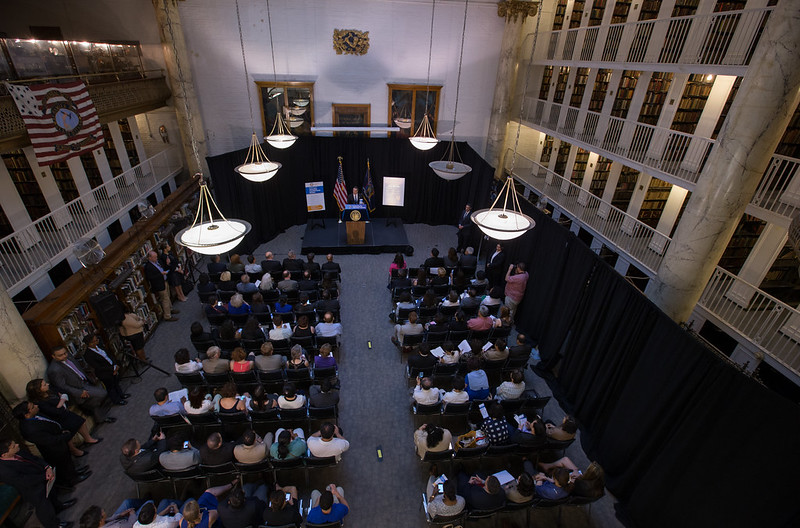
(photo: the governor's office)
Dallas Police Officer Amber Guyger faced up to 99 years for killing her neighbor, Botham Jean, in his own home. According to most observers, the forgiveness offered by Mr. Jean’s 18-year-old brother in his victim impact statement, capped by his request to hug Ms. Guyger, was the key reason why the jury settled on 10 years, a far lower number than even the 28 years urged by the prosecutor.
However important a role forgiveness played in the jury’s decision to spare Guyger decades behind bars, according to interviews with some of the jurors an even greater factor was Guyger’s expression of remorse during her trial testimony: “I’m so sorry,” she said. “I never wanted to take an innocent person’s life...I wish he was the one with the gun that killed me.”
The role of remorse in sentencing and punishment was a central theme of the recent Parole Summit organized by the Lifers and Longtermers Organization at Otisville Correctional Facility in New York.
In years past, the Summit focused on the parole process itself -- the parole interview, the parole decision, and appeals from parole denials -- and yielded suggestions for reforming an unforgiving system. But this year, the lifers decided to look inward, and bring to the forefront conceptions of restorative justice, victim centered awareness, and individual transformation.
The overarching emphasis on healing led inexorably to exhortations for offenders to gain insight into what led them to their crimes; to reflect on the motivations for their behavior. Many of the day’s speakers stressed that the lifers had to accept responsibility for the harm they caused, and to develop and express authentic contrition in order to promote healing for themselves as well as for their victims.
Criminal legal systems place a premium on remorse. Studies here and abroad have shown that remorse is the most commonly named mitigating factor for a reduced sentence, and perceived lack of remorse often leads to an enhanced sentence. Remorse is specifically and instrumentally relevant to the Parole Summit – most states allow parole boards to consider a person’s insight and remorse when deciding whether to grant parole, and parole boards typically probe those areas in depth at parole interviews. Many lifers have been denied parole based on a perceived lack of genuine or sufficient remorse.
Many rationales explain the outsize role remorse plays in sentencing and punishment. Sincere remorse as a sign of moral improvement suggests that the person has been rehabilitated and no longer poses a danger. Expressions of remorse also have a confessional aspect and are preconditions to receiving understanding or forgiveness. Remorse also serves as an apology to the victims and restores a measure of dignity that the crime violated.
But remorse is an emotion. Can anyone accurately evaluate whether a statement of remorse is genuine or self-serving? Typically, determinations of the authenticity of remorse are made by judges and members of parole boards who lack any training or special competence in assessing the complexities of human emotions. How do these evaluators distinguish remorse from guilt or from shame, or just generally decide whether a person is being sincere? Some people are better able to verbalize their feelings than are others, and cultural differences surely influence evaluations of remorse. How is remorse gauged when a person professes their innocence?
Studies show judges disagree about indicators of remorse – behavior that indicated remorse to some suggested remorselessness to others. Research has debunked the notion that remorse can be evaluated by words used, non-verbal cues, attitudes, and demeanor.
The many lifers denied parole for alleged inadequate contrition recognize that their words are necessary but not sufficient. It is too easy for words to be dismissed as uttered only in the hope of obtaining freedom. Instead, lifers want their remorse to be judged by their actions and deeds as well as by their words; by the affirmative steps they have taken while incarcerated to try to make amends for the harm they caused.
The reality of the enduring impact of remorse revealed a fundamental irony as the lifers listened patiently and attentively to remarks from prosecutors, members of the parole board, elected officials and others. While all the speakers talked about their reforms and self-defined progressive policies, something was missing.
Seated silently next to me was a man serving 50 years to life as a high-ranking prosecutor from the office that prosecuted him talked about all his office is doing in progressive criminal justice. Another man at my table who has been denied parole six times listened stoically as a parole board member talked about the virtue of accepting responsibility and expressing concern for victims – something the man has done to no avail at every one of his six parole appearances
By now, most people agree that prosecutors and those connected with law enforcement were the primary architects of mass incarceration. Yet what was sorely lacking from the speakers extolling the righteousness of victim-centeredness and offender accountability was any acknowledgement and acceptance of their individual, or their office’s, responsibility for the blight of mass incarceration. There was nothing said that remotely resembled insight, remorse, or apology.
And while words matter, in the end, just as lifers beg not to be judged solely by the words they utter in a brief and nerve-wracking parole interview but by their actions over the past many decades -- the things they have accomplished in prison and the men and women they have become -- law enforcement actors should be similarly judged.
Words matter, they are necessary if there is to be any reconciliation for past harms, but ultimately actions speak louder than words. If those who caused the crisis of mass incarceration and resultant decimation of families and communities cannot bring themselves to publicly accept responsibility and offer contrition to the tens of thousands of men and women serving life and massive long-term sentences, they can at the very least show their genuine and authentic remorse by taking every necessary step to secure their release.
***
Steven Zeidman is a professor of law at CUNY School of Law. On Twitter @SteveZeidman.
***
Have an op-ed idea or submission for Gotham Gazette? Email This email address is being protected from spambots. You need JavaScript enabled to view it.
State Health Department Must Reject Unneeded, Burdensome Luxury Hospital Expansion

rendering of proposed Leonx Hill Hospital expansion
Northwell Health is proposing an unprecedented, $2.5 billion expansion of Lenox Hill Hospital that includes construction and sale of a 490-foot condo tower to help finance a new 520-foot hospital tower and other massive new structures. This pitch has already generated much controversy, as residents of the Lenox Hill neighborhood and surrounding communities are speaking out forcefully against Northwell’s plan.
While it is widely understood that this development plan must go through the city’s land use approval process (known as ULURP) because of zoning changes Northwell is seeking, many New Yorkers are unaware that Northwell also needs approval from the State Department of Health before it can proceed with any expansion of Lenox Hill Hospital.
The crucial point here is that Northwell must apply to the State DOH to receive a “certificate of need” for its expansion plan. But the facts show that there truly is no need for this proposed expansion on the Upper East Side – and that is why the State DOH must reject the plan and send Northwell back to the drawing board.
This is a matter of common sense. In order to be granted a certificate of need, an institution should be able to demonstrate that its proposal promises to deliver something that is actually needed by the community. When it comes to Northwell’s plan for Lenox Hill Hospital, that is not the case.
We can all agree that Lenox Hill Hospital must offer high-quality, state-of-the-art medical care in a well-maintained facility. And if a straightforward modernization plan were all that Northwell were proposing, it would be worthy of support. In fact, it appears that Northwell has already begun financing its own upgrades at Lenox Hill Hospital, with a recent news story noting that officials have “hired a Michelin Star Chef” and made numerous other cosmetic improvements to provide a “luxury hotel experience.”
But the idea of building a monstrous luxury condo tower in the midst of a historic residential district to finance single-occupancy hospital rooms and destination medical facilities in one of the city’s most affluent and well-served areas is grandiose and insulting to community residents. Simply put, we do not need more hospital beds and significantly larger hospital facilities on the Upper East Side – and our community is not asking for them.
Let’s be clear: there are already more than 10,000 hospital beds in Manhattan, at least 3,000 of which are located throughout the Upper East Side. Our communities have access to healthcare facilities and specialty medical care that are the envy of our other-borough neighbors, many of whom have demanded better access to quality medical care.
Want to talk about healthcare needs? Look at the South Bronx, where low-income residents suffer from the state’s highest asthma rates. Look at Central Brooklyn, where national experts have called that community’s hospitals some of the worst in the entire nation.
If Northwell were truly interested in developing an expansion plan worthy of a “certificate of need,” it would seek out ways to bring more of its high-quality healthcare resources to communities like these. Instead, it is advancing a lucrative real estate development pitch that will create the tallest hospital in New York City and serve primarily to reap profits for its grandiose vision and satisfy the egos of its senior executives. All of this will take place at the expense of the local neighborhood, which will be forced to endure 10 years of hazardous construction and a massive condo tower that will destroy the fabric of a historic community.
The bottom line here is that if the State Department of Health follows its mandate to serve the healthcare needs of all New Yorkers and takes a thoughtful approach to evaluating these types of proposals, it has no choice but to reject Northwell’s plan and compel the institution to rethink its approach.
***
Andy Soussloff is a Lenox Hill resident and a member of the non-profit Committee to Protect Our Lenox Hill Neighborhood, Inc.
***
Have an op-ed idea or submission for Gotham Gazette? Email This email address is being protected from spambots. You need JavaScript enabled to view it.
PBMs Advocate for New York Consumers to Reduce Prescription Drug Costs
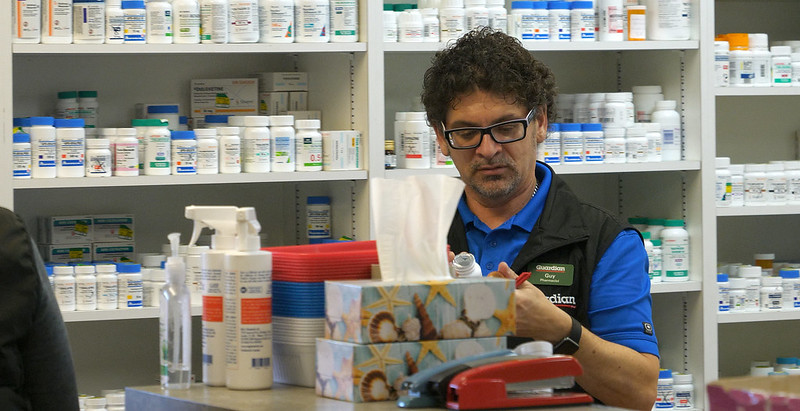
(photo: @albertarpap)
As the debate over prescription drug costs continues, it’s important to understand the role pharmacy benefit managers (PBMs) play in our health care system. Simply put, PBMs are the companies that are driving down prescription drug costs for New Yorkers and consumers nationwide.
PBMs are widely recognized for reducing prescription drug costs, but PBMs should also be recognized for improving clinical outcomes for patients. For example, PBMs perform a sophisticated evaluation of clinical evidence to construct prescription drug formularies that best fit the needs of patients. These prescription drug formularies lead to improved adherence for consumers and better health outcomes overall.
From a pure cost perspective, without PBMs consumers would pay on average $941 more per year per person, according to a 2016 Visante report. In addition, the report showed that over a 10-year period, PBMs will save New York’s consumers and health care programs nearly $40 billion.
PBMs achieve these savings by negotiating directly with drug manufacturers, who alone set and raise prices. The savings achieved by PBMs are used to lower premiums for all consumers in a health plan, or to reduce costs that consumers pay at the pharmacy counter.
Furthermore, any charge that PBMs are opposed to transparency is inaccurate. The fact is PBMs support transparency that leads to better health care outcomes. PBMs provide real-time benefit tools, so patients and their doctors understand which drugs are available and most affordable. In addition, PBMs provide information to clients on contracting terms, including how PBMs are paid for their services.
While it’s clear PBMs are reducing prescription drug costs, we understand that for too many people the costs are simply too high. For that reason, we encourage Governor Cuomo to look closely at whether recently passed legislation (S.6531) will lower health care costs for New Yorkers. In its current form, the bill eliminates many of the cost-saving tools PBMs employ to help keep consumer costs down and improve care.
The legislation puts consumer safety at risk by removing specialty pharmacy accreditation standards, and limits access to cost-effective drugs in favor of more expensive prescriptions. An analysis by Visante shows the bill would lead to $28 billion in additional prescription drug spending in New York over the next 10 years.
PBMs’ core mission is to advocate for consumers in the fight to reduce prescription drug costs. Increasing competition in the market and expanding PBMs’ cost-reducing tools is the best way to address the problem of high drug costs. Where there is sufficient competition, PBMs have a proven track record of success of lowering drug prices.
We’re committed to working with Governor Cuomo and members of the Legislature to address the prescription drug affordability problem where it exists and bring down drug costs and increase access for all New Yorkers.
***
JC Scott is President and CEO of the Pharmaceutical Care Management Association. On Twitter @pcmanet.
***
Have an op-ed idea or submission for Gotham Gazette? Email This email address is being protected from spambots. You need JavaScript enabled to view it.
Making the Democratic State Committee More Democratic and New York's DNC Delegation More Representative
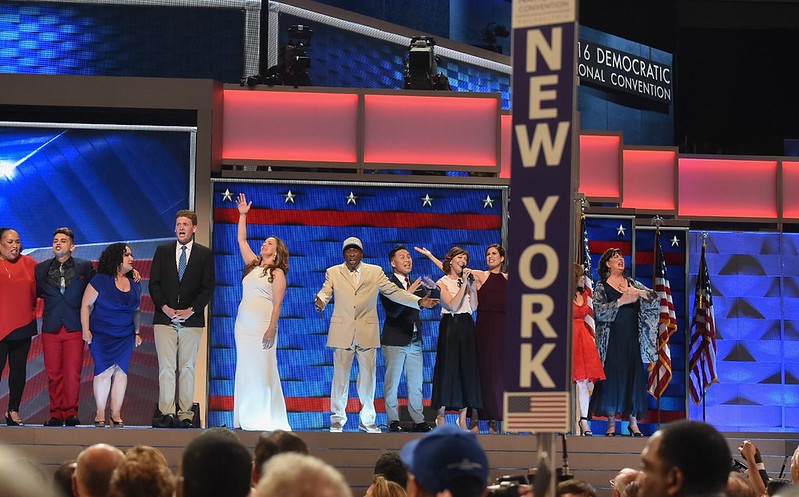
(photo: New York Democratic Party)
With 2020 approaching and a contentious Democratic presidential primary underway, all eyes are the Democratic National Committee (DNC) and its shepherding of the Demcoratic Party apparatus. Far fewer eyes are the Democratic State Committees, constituted in each state, which select the rarefied membership of the National Committee every four years.
In many states, State Committees are a big deal. They are the primary strategic planner for their party’s political efforts, and a key conduit for funding to candidates and local organizations. In New York, not so much. This is largely a function of the State Party’s leadership, and that attitude is well reflected in the State Committee’s picks for New York State’s DNC representatives.
In the DNC, each state is awarded representation through the state party’s Chair and Vice Chair, as well as members apportioned by a formula that accounts for population, Democratic Party enrollment, and votes cast for the Demcoratic candidate in the most recent presidential election. As a large, Democratic state, New York has a large voice on the DNC. The state’s influence is also felt in the fact that two of the DNC’s Vice Chairs, elected by the DNC members, are New Yorkers, further boosting its vote total.
As an influential, ethnically diverse state with a population almost evenly split between urban and non-urban residents, New York is uniquely positioned to champion a Democratic message that appeals to a broad swath of Americans. It’s hard to believe it does this, though, given the chosen composition of the state’s DNC delegation.
Of New York’s 11 elected members of the Democratic National Committee: zero are under 50 years old, though such New Yorkers are about 60% the state population; zero are from upstate, home to about 40% of New York’s population; zero are Hispanic, though about 20% of New York’s population is Hispanic; and zero are Asian, about 10% of New York’s population.
New York’s dismal failure in representation is meaningful, but it would be hard to know it. The DNC makes it extremely difficult for people to acquire the voting records of DNC decisions. An attempt to uncover how New York’s delegation voted on holding a climate debate and issue-based forums in the current presidential primary ran into an initial dead end with the New York State Committee, which says it doesn’t ask members how they vote, and the DNC, which says it only tells DNC members the voting results. This all seems odd for a body whose members are theoretically elected by, and responsible to, State Committees.
Ultimately, I obtained the rolls and they reveal that of New York’s 15 members (including those not elected by the State Committee), only two voted in favor of the holding a climate debate. Perhaps more shockingly, only eight of those who cast votes were there in person (it cannot be determined if the six New Yorkers who didn’t cast votes were present, though it seems likely they were both absent and without a proxy since they were not counted as abstentions). Regardless of how one feels about the climate debate, it seems likely that a different composition of the DNC delegation -- one more diverse, younger and engaged -- could have changed the vote total as well as the number of delegates that attended the meeting.
Last year, one of New York’s DNC seats was left vacant by the passing of Assemblymember Denny Farrell. On October 15, at their fall meeting, the State Committee selected his replacement. In the end, three candidates from Upstate New York ran: Buffalo Mayor Byron Brown, State Committeewoman Kelleigh McKenzie, and State Committeewoman Elisa Sumner. Brown, who also served as Governor Cuomo’s heavy-handed Chair of the State Committee until he was ousted after the 2018 scandal involving a mailer falsely smearing Cuomo’s primary opponent, won with over 60% of the vote.
While the election of an African-American man from Upstate is a step in the right direction, it remains palpably insufficient. African-Americans are the only minority group adequately represented in the DNC delegation while a single upstate member shortchanges nearly half the state’s population -- particularly the part most experienced in winning elections against Republicans.
Brown’s election also represents a continuation of the political status quo. As a long-term ally of Governor Cuomo and a State Chair who often ignored the democratic process, Brown’s ascension to the DNC is likely to maintain New York’s support for business as usual.
If people feel detached from the mechanics of the Democratic Party, they needn’t. In 2020 voters will have a chance to elect their State Committee members -- one male and one female per Assembly District. Those members will then immediately meet to select New York’s DNC members. In the past, the State Committee has rubber-stamped a slate chosen by the Democratic Party elite composed mainly of elected officials and power-brokers. Next time, it looks like there could be a contest for DNC membership and a push for a Democratic Party that represents New York’s Democrats.
***
Ben Yee is a civic educator and organizer in New York City. He is a Democratic State Committeeman for New York’s 66th Assembly District. On Twitter at @yben.
***
Have an op-ed idea or submission for Gotham Gazette? Email This email address is being protected from spambots. You need JavaScript enabled to view it.
To End the Homelessness Crisis It’s Time to Refocus the City’s Housing Plan - Here’s How
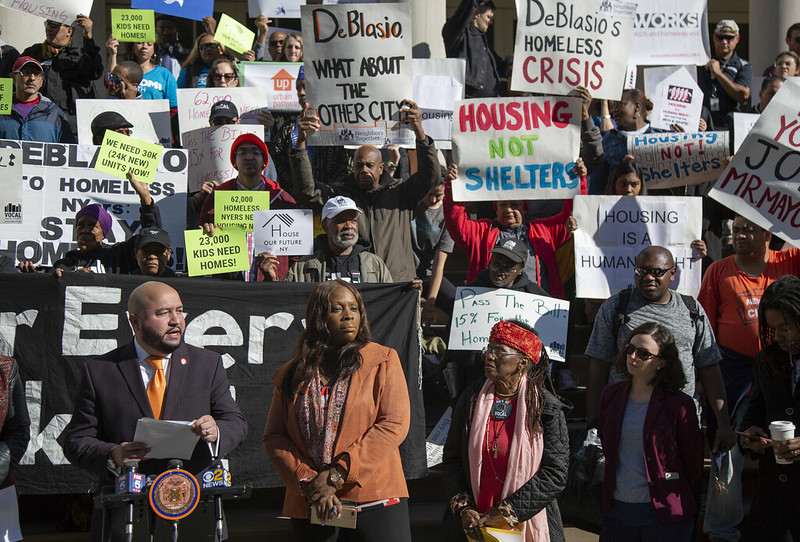
The authors and others at a rally (photo: John McCarten/City Council)
More than 61,000 men, women, and children will sleep in New York City shelters tonight, and this historic homelessness crisis will continue to devastate the lives of even more people unless Mayor de Blasio embraces the common sense plans that we have put forward from a City Council office and the Coalition for the Homeless, respectively.
The record number of homeless New Yorkers will continue to reach new highs every year, according to the latest report from the Coalition. In stark contrast to Mayor de Blasio’s predicted decrease in the shelter census of a mere 2,500 people by 2022, the Coalition’s analysis shows that the number of city residents living in shelters will increase by 5,000 people in that time period.
While the mayor often touts the work his administration has done to prevent homelessness and protect tenants, his failure to meaningfully reduce the shelter census is a direct result of the lack of truly affordable apartments created specifically to house homeless New Yorkers. This is why the House Our Future NY Campaign, with the support of the majority of the New York City Council, has spent more than a year and a half calling on Mayor de Blasio to make his Housing New York 2.0 plan -- badly in need of a third iteration -- address the true scale of the homelessness crisis.
Of the 300,000 apartments the Housing New York 2.0 plan will create or preserve by 2026, only 15,000 apartments will be set aside for homeless New Yorkers – and just 6,000 of those will be created through new construction. The remaining 9,000 of those apartments in the mayor’s plan will be set aside for homeless New Yorkers through the preservation of already-occupied units, which will remain unavailable to homeless New Yorkers for many years.
To address the housing needs of our homeless neighbors, the House Our Future NY Campaign, formed by the Coalition and 66 partner organizations, urges Mayor de Blasio to create 24,000 apartments through new construction (about 20 percent of all planned new construction in Housing New York 2.0) and preserve at least 6,000 more units for a total of 30,000 apartments for homeless New Yorkers.
In the Bronx, we have seen how the issue of homelessness impacts people firsthand. Many hurtful and false narratives have been spread about people in the shelter system, primarily that individuals are unemployed or are looking for handouts. To the contrary, many in the system have full-time jobs or are living on fixed-incomes and turn to the shelter system as a last resort because of rising rents in their communities. Once in the system, people face a lengthy wait to be placed in permanent housing due to a lack of truly affordable housing.
To address this issue and the staggering number of individuals and families in the shelter system, we introduced legislation, Intro. 1211, which requires all new housing developments that receive city financial assistance to set aside at least 15 percent of new apartments for homeless households.
Working together to raise awareness on this proposal, Intro. 1211 has secured a veto-proof majority of Council members signed on as co-sponsors, as well as the support of Public Advocate Jumaane Williams. While an overwhelming number of homeless advocates came out in support of the bill at a public hearing held in December 2018, the de Blasio administration declared its opposition to the bill, citing financial concerns. But we have demonstrated that more affordable housing can be built for homeless New Yorkers than is conceptualized in the mayor’s plan.
Starting in April 2018 while drafting the language for Intro. 1211, we began requiring developers who were looking to build housing in Council District 17 in the Bronx to set aside a minimum of 15 percent of developed units for homeless individuals and families. Despite the administration’s insistence that the financing would not work, we were able to secure a 15 percent homeless set-aside in every new construction project that required our Council approval.
In total, our Council office approved 121 new set-aside units over eight projects. While this number of units is a drop in the bucket of the overall need for our homeless population, it shows the impact this legislation could have in changing the tide on homelessness if implemented across New York City.
We are pleased that Intro. 1211 is already having a positive effect on the movement to build more housing for homeless people. Many Council colleagues have begun requiring a 15 percent set-aside minimum in projects in their own districts. With a citywide policy to substantially increase new housing built for homeless New Yorkers, we would be able to move more people out of city shelters and achieve the goal of reaching the 24,000 new units the House Our Future NY Campaign is advocating for.
We cannot continue to accept mass homelessness in our city as a fact of life. We have the means to alleviate the suffering of tens of thousands of homeless New Yorkers by building more deeply subsidized affordable housing to match the scale of the need. In addition to being the moral thing to do, the New York City Council has demonstrated through its support of the House Our Future NY Campaign and Intro. 1211 that it is entirely feasible. Now it is time for Mayor de Blasio to finally address the ongoing homelessness crisis with the best tool available: building new affordable apartments for homeless New Yorkers.
***
City Council Member Rafael Salamanca Jr. represents parts of the Bronx. Giselle Routhier is Policy Director at Coalition for the Homeless. On Twitter @Salamancajr80 & @Giselle_Ashley.
***
Have an op-ed idea or submission for Gotham Gazette? Email This email address is being protected from spambots. You need JavaScript enabled to view it.